Courses


 Compare
Compare
Books and burials are two important sources of historical information. They can provide insights into the past, revealing details about people's lives, beliefs, and societies. Books can offer: Written records: Historical accounts, stories, poems, and other texts. Cultural information: Insights into language, religion, art, and philosophy. Social and political history: Details about government, laws, and social structures. Burials can offer: Archaeological evidence: Clues about burial practices, rituals, and beliefs. Material culture: Information about clothing, jewelry, and other objects. Social status: Evidence of social hierarchies and inequality. Scientific data: Insights into health, diet, and environmental conditions. By studying books and burials, historians can piece together the puzzle of the past and learn about the people who lived in it. বই এবং সমাধি ঐতিহাসিক তথ্যের দুটি গুরুত্বপূর্ণ উৎস। তারা মানুষের জীবন, বিশ্বাস এবং সমাজ সম্পর্কে বিশদ প্রকাশ করে অতীতের অন্তর্দৃষ্টি প্রদান করতে পারে। বইগুলি দিতে পারেঃ লিখিত নথিঃ ঐতিহাসিক বিবরণ, গল্প, কবিতা এবং অন্যান্য গ্রন্থ। সাংস্কৃতিক তথ্যঃ ভাষা, ধর্ম, শিল্প এবং দর্শনের অন্তর্দৃষ্টি। সামাজিক ও রাজনৈতিক ইতিহাসঃ সরকার, আইন এবং সামাজিক কাঠামো সম্পর্কে বিশদ। কবর দেওয়া যেতে পারেঃ প্রত্নতাত্ত্বিক প্রমাণঃ সমাধি প্রথা, আচার-অনুষ্ঠান এবং বিশ্বাস সম্পর্কে সূত্র। বস্তুগত সংস্কৃতিঃ পোশাক, গয়না এবং অন্যান্য জিনিস সম্পর্কে তথ্য। সামাজিক অবস্থানঃ সামাজিক শ্রেণিবিন্যাস এবং বৈষম্যের প্রমাণ। বৈজ্ঞানিক তথ্যঃ স্বাস্থ্য, খাদ্য এবং পরিবেশগত অবস্থার অন্তর্দৃষ্টি। বই এবং সমাধিগুলি অধ্যয়ন করে, ইতিহাসবিদরা অতীতের ধাঁধাটি একত্রিত করতে পারেন এবং সেখানে বসবাসকারী লোকদের সম্পর্কে জানতে পারেন।
0 Lessons
Hours

 Compare
Compare
The Earliest Cities refers to the development of the first urban centers in human history. These cities emerged in different parts of the world at various times, often near rivers or other sources of water. They were characterized by: Population growth: A large concentration of people living together. Division of labor: People specializing in different tasks (e.g., farming, crafts, trade). Complex social structures: Hierarchies, governments, and organized religion. Advanced technology: Tools, buildings, and infrastructure. Trade and exchange: Networks of trade routes connecting different cities. Some of the earliest cities include Mesopotamia (in modern-day Iraq), the Indus Valley Civilization (in modern-day Pakistan), and ancient Egypt. These cities played a crucial role in shaping the course of human history, contributing to advancements in art, science, and culture. প্রাচীনতম শহরগুলি মানব ইতিহাসের প্রথম শহুরে কেন্দ্রগুলির বিকাশকে বোঝায়। এই শহরগুলি বিভিন্ন সময়ে বিশ্বের বিভিন্ন অংশে আবির্ভূত হয়েছিল, প্রায়শই নদী বা জলের অন্যান্য উৎসের কাছে। তাদের দ্বারা চিহ্নিত করা হয়েছিলঃ জনসংখ্যা বৃদ্ধিঃ একসঙ্গে বসবাসকারী মানুষের একটি বড় ঘনত্ব। শ্রম বিভাগঃ বিভিন্ন কাজে বিশেষজ্ঞ ব্যক্তিরা (e.g., farming, crafts, trade). জটিল সামাজিক কাঠামোঃ শ্রেণিবিন্যাস, সরকার এবং সংগঠিত ধর্ম। উন্নত প্রযুক্তিঃ সরঞ্জাম, ভবন এবং পরিকাঠামো। বাণিজ্য ও বিনিময়ঃ বিভিন্ন শহরকে সংযুক্তকারী বাণিজ্য পথের নেটওয়ার্ক। প্রাচীনতম কয়েকটি শহরের মধ্যে রয়েছে মেসোপটেমিয়া (আধুনিক ইরাকে), সিন্ধু সভ্যতা (আধুনিক পাকিস্তানে) এবং প্রাচীন মিশর। এই শহরগুলি শিল্প, বিজ্ঞান এবং সংস্কৃতির অগ্রগতিতে অবদান রেখে মানব ইতিহাসের গতিপথ গঠনে গুরুত্বপূর্ণ ভূমিকা পালন করেছিল।
0 Lessons
Hours
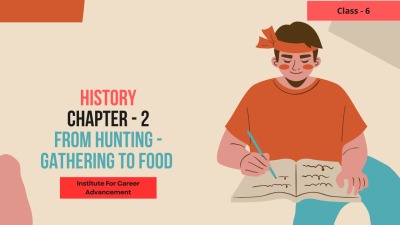
 Compare
Compare
Hunting-gathering was the earliest way of life for humans. People would roam around, searching for food like animals and plants. As time passed, they learned to grow their own food through agriculture. This shift from hunting-gathering to agriculture was a major turning point in human history. Hunting-gathering involved: Hunting animals for meat. Gathering wild plants for food and other purposes. Living nomadic lives as they followed food sources. Agriculture involved: Cultivating crops like wheat, rice, and corn. Domesticating animals like cows, sheep, and pigs. Living in settled communities near their farms. The transition from hunting-gathering to agriculture led to significant changes in human society. It allowed people to settle down in one place, develop new technologies, and create larger communities. However, it also brought new challenges, such as dependence on weather and soil conditions. শিকার-সংগ্রহই ছিল মানুষের জীবনের প্রাচীনতম উপায়। মানুষ প্রাণী ও উদ্ভিদের মতো খাদ্যের সন্ধানে ঘুরে বেড়াত। সময়ের সঙ্গে সঙ্গে তাঁরা কৃষির মাধ্যমে নিজেদের খাদ্য উৎপাদন করতে শিখেছিলেন। শিকার-সংগ্রহ থেকে কৃষিতে এই পরিবর্তন মানব ইতিহাসের একটি প্রধান সন্ধিক্ষণ ছিল। শিকার-সমাবেশের সঙ্গে জড়িত রয়েছেঃ মাংসের জন্য প্রাণী শিকার করা। খাদ্য এবং অন্যান্য উদ্দেশ্যে বন্য উদ্ভিদ সংগ্রহ করা। যাযাবররা খাদ্যের উৎস অনুসরণ করে জীবনযাপন করে। কৃষিকাজের সঙ্গে যুক্তঃ গম, ধান এবং ভুট্টার মতো ফসল চাষ করা। গরু, ভেড়া এবং শূকরের মতো গৃহপালিত প্রাণী। তাদের খামারের কাছাকাছি বসতি স্থাপনকারী সম্প্রদায়ের মধ্যে বসবাস করা। শিকার-সংগ্রহ থেকে কৃষিতে রূপান্তর মানব সমাজে উল্লেখযোগ্য পরিবর্তন নিয়ে আসে। এটি মানুষকে এক জায়গায় বসতি স্থাপন করতে, নতুন প্রযুক্তি বিকাশ করতে এবং বৃহত্তর সম্প্রদায় তৈরি করতে দেয়। তবে, এটি আবহাওয়া এবং মাটির অবস্থার উপর নির্ভরতার মতো নতুন চ্যালেঞ্জও নিয়ে এসেছিল।
0 Lessons
Hours
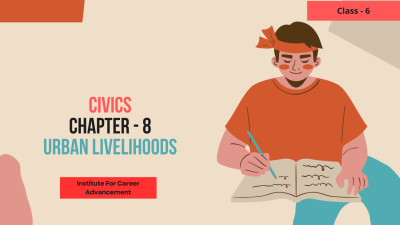
 Compare
Compare
Urban livelihoods refer to the ways people in cities and towns make a living. Unlike rural areas, which often rely on agriculture and natural resources, urban communities offer a diverse range of occupations and industries. Common urban livelihoods include: Services: Retail, healthcare, education, transportation, hospitality, and finance. Manufacturing: Production of goods in factories and workshops. Construction: Building and maintaining infrastructure (roads, buildings, bridges). Technology: Information technology, software development, and telecommunications. Government: Public service jobs in administration, law enforcement, and education. Arts and culture: Creative professions like music, theater, film, and design. Urban livelihoods are influenced by factors such as education, skills, and economic opportunities. While cities offer a wide range of job options, they also face challenges like competition, unemployment, and the cost of living. শহুরে জীবিকা বলতে শহর ও শহরের মানুষের জীবিকা নির্বাহের উপায়কে বোঝায়। গ্রামীণ অঞ্চলগুলির বিপরীতে, যা প্রায়শই কৃষি ও প্রাকৃতিক সম্পদের উপর নির্ভর করে, শহুরে সম্প্রদায়গুলি বিভিন্ন ধরনের পেশা এবং শিল্প সরবরাহ করে। সাধারণ শহুরে জীবিকা অন্তর্ভুক্তঃ পরিষেবাঃ খুচরো, স্বাস্থ্যসেবা, শিক্ষা, পরিবহন, আতিথেয়তা এবং অর্থ। উৎপাদনঃ কারখানা ও কর্মশালায় পণ্য উৎপাদন। নির্মাণঃ পরিকাঠামো নির্মাণ ও রক্ষণাবেক্ষণ (roads, buildings, bridges). প্রযুক্তিঃ তথ্য প্রযুক্তি, সফ্টওয়্যার উন্নয়ন এবং টেলিযোগাযোগ। সরকারঃ প্রশাসন, আইন প্রয়োগকারী এবং শিক্ষায় জনসেবার চাকরি। শিল্প ও সংস্কৃতিঃ সঙ্গীত, থিয়েটার, চলচ্চিত্র এবং নকশার মতো সৃজনশীল পেশা। শহুরে জীবিকা শিক্ষা, দক্ষতা এবং অর্থনৈতিক সুযোগের মতো বিষয়গুলির দ্বারা প্রভাবিত হয়। যদিও শহরগুলি চাকরির বিস্তৃত বিকল্প সরবরাহ করে, তারা প্রতিযোগিতা, বেকারত্ব এবং জীবনযাত্রার ব্যয়ের মতো চ্যালেঞ্জেরও মুখোমুখি হয়।
0 Lessons
Hours
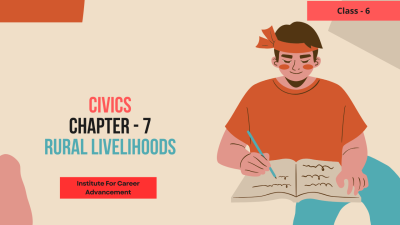
 Compare
Compare
Rural livelihoods refer to the ways people in rural areas make a living. Unlike urban areas with diverse industries, rural communities often rely on natural resources and traditional skills for their sustenance. Common rural livelihoods include: Agriculture: Growing crops, raising livestock, or both. Forestry: Harvesting timber, collecting forest products (like honey, herbs), or working in forest conservation. Fishing: Catching fish or other aquatic creatures. Livestock rearing: Breeding and raising animals for meat, milk, or other products. Cottage industries: Small-scale businesses that produce goods at home or in workshops. Tourism: Attracting visitors to rural areas for sightseeing, adventure activities, or cultural experiences. These livelihoods are often interconnected. For example, farmers may also rear livestock or engage in cottage industries to supplement their income. Rural communities face unique challenges, such as limited access to markets, infrastructure, and technology. However, they also possess valuable knowledge and skills that can contribute to sustainable development. গ্রামীণ জীবিকা বলতে গ্রামীণ এলাকার মানুষের জীবিকা নির্বাহের উপায়কে বোঝায়। বিভিন্ন শিল্প সহ শহুরে অঞ্চলের বিপরীতে, গ্রামীণ সম্প্রদায়গুলি প্রায়শই তাদের জীবিকার জন্য প্রাকৃতিক সম্পদ এবং ঐতিহ্যবাহী দক্ষতার উপর নির্ভর করে। সাধারণ গ্রামীণ জীবিকা অন্তর্ভুক্তঃ কৃষিঃ ফসল উৎপাদন, গবাদি পশু পালন বা উভয়ই। বনায়নঃ কাঠ কাটা, বনজ পণ্য (যেমন মধু, ভেষজ) সংগ্রহ করা বা বন সংরক্ষণে কাজ করা। মাছ ধরাঃ মাছ বা অন্যান্য জলজ প্রাণী ধরা। গবাদি পশু পালনঃ মাংস, দুধ বা অন্যান্য পণ্যের জন্য প্রজনন এবং গবাদি পশু পালন। কুটির শিল্পঃ ছোট আকারের ব্যবসা যা বাড়িতে বা কর্মশালায় পণ্য উৎপাদন করে। পর্যটনঃ দর্শনীয় স্থান, রোমাঞ্চকর কার্যকলাপ বা সাংস্কৃতিক অভিজ্ঞতার জন্য গ্রামাঞ্চলে দর্শনার্থীদের আকৃষ্ট করা। এই জীবিকা প্রায়শই আন্তঃসংযুক্ত থাকে। উদাহরণস্বরূপ, কৃষকরা তাদের আয়ের পরিপূরক হিসাবে গবাদি পশু পালন করতে পারে বা কুটির শিল্পেও জড়িত হতে পারে। গ্রামীণ সম্প্রদায়গুলি বাজার, পরিকাঠামো এবং প্রযুক্তিতে সীমিত প্রবেশাধিকারের মতো অনন্য চ্যালেঞ্জের মুখোমুখি হয়। তবে, তাদের মূল্যবান জ্ঞান ও দক্ষতা রয়েছে যা টেকসই উন্নয়নে অবদান রাখতে পারে।
0 Lessons
Hours

 Compare
Compare
Urban Administration for Class 6 focuses on the organization and management of cities and towns. It explains how local governments, like municipal corporations or municipalities, are responsible for providing essential services such as water supply, sanitation, street lighting, waste management, and maintaining public spaces. The chapter also covers the roles of key officials, such as the mayor and municipal commissioner, and how citizens interact with urban administrative bodies for various civic issues. ষষ্ঠ শ্রেণীর জন্য নগর প্রশাসন শহর ও শহরগুলির সংগঠন ও ব্যবস্থাপনার উপর দৃষ্টি নিবদ্ধ করে। এটি ব্যাখ্যা করে যে কীভাবে পৌর কর্পোরেশন বা পৌরসভার মতো স্থানীয় সরকারগুলি জল সরবরাহ, স্যানিটেশন, রাস্তার আলো, বর্জ্য ব্যবস্থাপনা এবং সর্বজনীন স্থানগুলির রক্ষণাবেক্ষণের মতো প্রয়োজনীয় পরিষেবা প্রদানের জন্য দায়বদ্ধ। এই অধ্যায়ে মেয়র ও পৌর কমিশনারের মতো প্রধান কর্মকর্তাদের ভূমিকা এবং নাগরিকরা কীভাবে বিভিন্ন নাগরিক সমস্যার জন্য শহুরে প্রশাসনিক সংস্থাগুলির সাথে যোগাযোগ করে তাও অন্তর্ভুক্ত করা হয়েছে।
0 Lessons
Hours
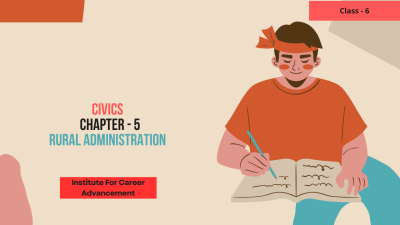
 Compare
Compare
Rural Administration - Class 6 is a course that explores the unique challenges and opportunities faced by rural communities. It delves into the role of local governments in rural areas, the importance of rural development, and the impact of rural-urban migration. গ্রামীণ প্রশাসন-ষষ্ঠ শ্রেণি এমন একটি কোর্স যা গ্রামীণ সম্প্রদায়ের অনন্য চ্যালেঞ্জ এবং সুযোগগুলি অন্বেষণ করে। এটি গ্রামাঞ্চলে স্থানীয় সরকারের ভূমিকা, গ্রামীণ উন্নয়নের গুরুত্ব এবং গ্রামীণ-শহুরে অভিবাসনের প্রভাব নিয়ে আলোচনা করে।
0 Lessons
Hours
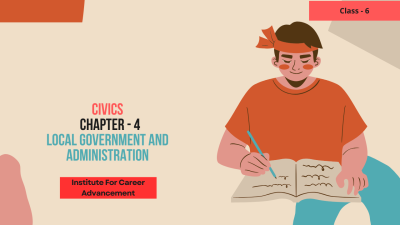
 Compare
Compare
Local Government and Administration - Class 6 is a course that explores the structure, functions, and importance of local governments. It delves into the different levels of local government, their roles in providing services, and the ways in which citizens can participate in local governance. স্থানীয় সরকার এবং প্রশাসন-ক্লাস 6 একটি কোর্স যা স্থানীয় সরকারের কাঠামো, কার্যকারিতা এবং গুরুত্ব অন্বেষণ করে। এটি স্থানীয় সরকারের বিভিন্ন স্তর, পরিষেবা প্রদানের ক্ষেত্রে তাদের ভূমিকা এবং স্থানীয় প্রশাসনে নাগরিকরা কীভাবে অংশগ্রহণ করতে পারে তা নিয়ে আলোচনা করে।
0 Lessons
Hours

 Compare
Compare
Government - Class 6 is a course that explores the concept of government, its functions, and its role in society. It delves into different forms of government, the principles of democracy, and the rights and responsibilities of citizens. সরকার-ক্লাস 6 একটি কোর্স যা সরকারের ধারণা, এর কার্যকারিতা এবং সমাজে এর ভূমিকা অন্বেষণ করে। এটি সরকারের বিভিন্ন রূপ, গণতন্ত্রের নীতি এবং নাগরিকদের অধিকার ও দায়িত্ব নিয়ে আলোচনা করে।
0 Lessons
Hours